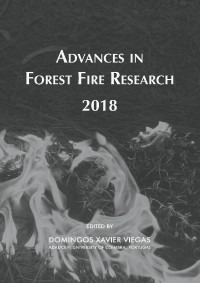Please use this identifier to cite or link to this item:
https://hdl.handle.net/10316.2/44579| Title: | Modelling the rate of spread of fire: an SDE approach | Authors: | Jovanoski, Zlatko Sharples, Jason J. Gill, A. Malcolm Watt, Simon Sidhu, Harvinder S. Towers, Isaac N. Sanni, Smaila |
Keywords: | Fire growth;fire acceleration;rate of spread;nonlinear curve-fitting;stochastic differential equation | Issue Date: | 2018 | Publisher: | Imprensa da Universidade de Coimbra | Journal: | http://hdl.handle.net/10316.2/44517 | Abstract: | From a point source, landscape fires accelerate until they reach a quasi-equilibrium rate of spread. The rate at which a fire accelerates from its ignition affects the time first responders have to attack a fire in its initial stages when it is more easily suppressed. As such, knowledge of the rate of acceleration of a fire from ignition can be valuable from a fire management perspective. However, the majority of studies in wildland fire science have been dedicated to development of models for the quasi-equilibrium rate of spread attained by the fire after its acceleration phase. Comparatively little attention has been given to the development of models that specifically account for the growth phase of a fires development. The rate of acceleration depends on many factors including variations in ambient and induced wind speed and direction, variation in moisture content of the fuel, fuel stratification and slope variation. Present models of fire growth from a point ignition are expressed as deterministic algebraic equations, thereby neglecting variability. The numerous variables involved make predictions of rate of spread from a point source very difficult. In this paper we consider two approaches to model the acceleration phase of a fire. The first considers fitting a sigmoidal (logistic) function to experimental data using a nonlinear regression procedure. In the second approach we propose the use of stochastic differential equations to investigate the growth of a fire to quasi-equilibrium. In addition to providing a more realistic portrayal of the time series data relating to fire growth, this second approach allows for better discrimination of the mechanisms driving the growth phase of fire spread. The models are assessed by appealing to observations of experimental fire growth. Specifically the data relate to fires growing from a point ignition under the influence of a uniform wind. The results indicate that both approaches can provide an accurate representation of the observed data, but that the approach based on stochastic differential equations yields 95% prediction bounds that are narrower than those obtained from the nonlinear regression. The difference in prediction bounds indicates that the way stochasticity is incorporated into fire growth models has implications for how models inform decisions about the likelihood of a fire self-extinguishing before it reaches quasi-equilibrium, and the magnitude of the rates of spread it is likely to exhibit during the initial stages of growth. | URI: | https://hdl.handle.net/10316.2/44579 | ISBN: | 978-989-26-16-506 (PDF) | DOI: | 10.14195/978-989-26-16-506_62 | Rights: | open access |
| Appears in Collections: | Advances in forest fire research 2018 |
Files in This Item:
| File | Description | Size | Format | |
|---|---|---|---|---|
| modelling_the_rate_of_spread_of_fire.pdf | 1.21 MB | Adobe PDF |  |
Items in DSpace are protected by copyright, with all rights reserved, unless otherwise indicated.
